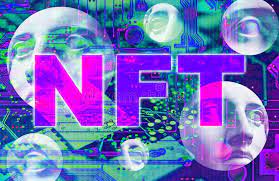What is an NFT?

We have recently seen the rise of NFT’s or Non-Fungible Tokens all over social media. The craze produced $25 billion in sales in 2021. Many celebrities such as John Cena, Eminem, Snoop Dogg, Shawn Mendes and many more have helped catapult this cryptocurrency phenomenon.
What are NFT’s?
NFT’s are essentially digital tokens that provide proof of ownership records in cryptographic metadata, making them exclusive to the buyer. When looking at the actual name “NFT,” the word fungible means replaceable, so NFT by definition means a non-replaceable digital token. That may sound foreign to you but putting it simply, NFT’s are used to prove ownership of an exclusive object.
What are the Different Kinds
NFT’s come in various forms such as art, video game items, music, event tickets, trading cards/collectibles, memes, domain names, ownership records, virtual fashion and miscellaneous online items. They can be just about anything that you can think of. For instance, former Twitter CEO Jack Dorsey sold the first tweet ever as an NFT for over $2.9 million. “The Merge” NFT by digital artist Pak had sales that reached $91.8 million due to an abundance of people buying massive pieces of the art piece.
Why are they so Popular?
The advocacy of celebrities has had a profound effect on the popularity of NFT’s. However I believe that the exclusivity of NFT’s primarily drives their popularity. Once you purchase an NFT, you are the only person in the world who has that particular NFT; using uniqueness as a selling point has never really been explored. Furthermore, digital goods have been sold online before but not with the appealing aspect of exclusivity.
Are they here to stay, and why are they so scrutinized?
In my honest opinion, I think that it is unfair to loop an entire industry into a stigmatized space. I believe that vast ignorance of the phenomenon leads to mass distrust and condemnation of NFT’s. Simply put, society hates what it doesn’t understand and despises ambiguity. Ultimately, I think that NFT’s can serve a variety of utilities. However, I forecast issues like piracy to be a concern for the industry.

An award-winning senior Communications major from Atlanta, Georgia, Jabari is passionate about bringing diverse perspectives to the news. He has been with...









Jake • Jan 18, 2022 at 10:23 am
I don’t feel this article presents a balanced or even slightly informed view of NFTs, and that is a big problem considering the title. Why have you not mentioned the obscene energy consumption associated with the practice? The process of a single person minting a NFT consumes more energy than most of use use in years of our lives. The progress we have made with solar energy has already been wholly cancelled out by the energy consumption of NFTs.
In an era where we are facing one climate disaster after another due to our excessive use of energy, is it really the time to be pursuing a new greedy capitalistic endeavor?
You also cite uniqueness as a selling point, but anyone can copy and paste an NFT easily. The Mona Lisa is unique. You can buy unique prints of art from actual artists anywhere in the world, and people have been doing so for centuries. A little stick-figure drawing I can make on a napkin is already more unique than any image ever posted on the Internet, because there is no way to post anything on the Internet without it being copied.
I understand this is an opinion piece, but I do wish you would put more effort into presenting the proven negatives of NFTs instead of vaguely alluding to society’s hatred for something it doesn’t understand. We DO understand NFTs: we understand that they are the newest grifter scheme of the 21st century, designed to make young people believe they can get rich quickly. Meanwhile, struggling artists and the environment are being grossly exploited.